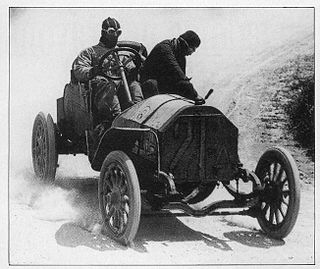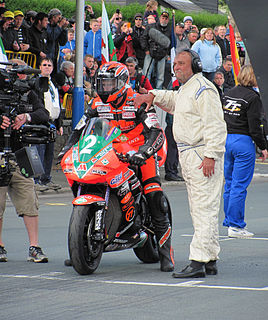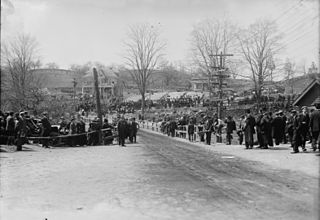
The Isle of Man TT or Tourist Trophy races are an annual motorcycle racing event run on the Isle of Man in May/June of most years since its inaugural race in 1907. The event is often called one of the most dangerous racing events in the world.

The Indianapolis Motor Speedway is an automobile racing circuit located in Speedway, Indiana in the United States. It is the home of the Indianapolis 500 and the Verizon 200, and formerly the home of the United States Grand Prix. It is the largest sports venue in the world. It is located on the corner of 16th Street and Georgetown Road, approximately six miles (10 km) west of Downtown Indianapolis.

Silverstone Circuit is a motor racing circuit in England, near the Northamptonshire villages of Silverstone and Whittlebury. It is the current home of the British Grand Prix, which it first hosted as the 1948 British Grand Prix. The 1950 British Grand Prix at Silverstone was the first race in the newly created World Championship of Drivers. The race rotated between Silverstone, Aintree and Brands Hatch from 1955 to 1986, but settled permanently at the Silverstone track in 1987. The circuit also hosts the British round of the MotoGP series.

The Targa Florio was an open road endurance automobile race held in the mountains of Sicily near the island's capital of Palermo. Founded in 1906, it was the oldest sports car racing event, part of the World Sportscar Championship between 1955 and 1973. While the first races consisted of a whole tour of the island, the track length in the race's last decades was limited to the 72 kilometres (45 mi) of the Circuito Piccolo delle Madonie, which was lapped 11 times.

The 1911 International 500-Mile Sweepstakes Race was held at the Indianapolis Motor Speedway on Tuesday, May 30, 1911. It was the inaugural running of the Indianapolis 500, which is one of the most prestigious automobile races in the world. Ray Harroun, an engineer with the Marmon Motor Car Company, came out of retirement to drive, and won the inaugural event before re-retiring for good in the winner's circle.
The Porsche Supercup is an international one-make racing premier series supporting the FIA Formula One World Championship organized by Porsche Motorsport GmbH.

The Porsche 911 GT2 is a high-performance, track-focused sports car built by the German automobile manufacturer Porsche from 1993 to 2009, and then since 2010 as the GT2 RS. It is based on the 911 Turbo, and uses a similar twin-turbocharged engine, but features numerous upgrades, including engine upgrades, larger brakes, and stiffer suspension calibration. The GT2 is significantly lighter than the Turbo due to its use of rear-wheel-drive instead of all-wheel-drive system and the reduction or removal of interior components. As a result, the GT2 is the most expensive and fastest model among the 911 lineup.

The Isle of Man TT Mountain Course or TT Course is a motorcycle road-racing circuit located in the Isle of Man. The motorcycle TT Course is used principally for the Isle of Man TT Races and also the separate event of the Isle of Man Festival of Motorcycling for the Manx Grand Prix and Classic TT Races held in September of each year. The start-line for the Isle of Man TT Mountain Course is located on Glencrutchery Road in the town of Douglas, Isle of Man.

The Senior Tourist Trophy is a motorcycle road race that takes place during the Isle of Man TT festival, an annual event traditionally held over the last week in May and the first week in June. The Senior TT is the Blue Riband event of the festival that takes place on the Friday of race week, with "The Marquis de Mouzilly St. Mars trophy" awarded to the winner.
Further changes occurred in the 1926 Isle of Man Tourist Trophy with the scrapping of the Side-Car TT and Ultra-Lightweight TT Races from the lack of entries. Most of the TT Course had now been tarmacked, including the Snaefell Mountain Section. Another change in 1926 was the ban on alcohol based fuels, forcing competitors to use road petrol. Despite these changes the prestige of the Isle of Man TT Races had encouraged the Italian motor-cycle manufacturers Bianchi, Garelli and Moto Guzzi to enter.
Charles Cleveland Merz was an American racecar driver, military officer, engineering entrepreneur, and racing official. Active in the early years of the Indianapolis 500, he later became Chief Steward of the Memorial Day Classic.

The Junior TT is a motorcycle road race that takes place during the Isle of Man TT festival; an annual event at the end of May and beginning of June. Between 1949 and 1976 this race was part of the Grand Prix motorcycle racing season.

The Lightweight TT is a motorcycle road race that is a part of the Isle of Man TT festival - an annual motorcycle event traditionally held over the last week of May and first week of June.

The IndyCar Series, currently known as the NTT IndyCar Series under sponsorship, is the premier level of open-wheel racing in North America. Its parent company began in 1996 as the Indy Racing League (IRL), which was created by then Indianapolis Motor Speedway owner Tony George as a competitor to CART. CART operated under the "IndyCar" name from 1992 until 1996, when they agreed to change their name to Champ Car after a series of lawsuits, with the proviso that the IRL would not use "IndyCar" until after the 2002 season. In 2008, the IndyCar Series merged with CART's successor, the Champ Car World Series. The series is self-sanctioned by its parent company, INDYCAR, LLC.
The Ultra-Lightweight TT was a motorcycle road race that took place during the Isle of Man TT festival, an annual event at the end of May and beginning of June. Between 1951 and 1974 this race was part of the Grand Prix motorcycle racing season at world-level, representing the British round. The Ultra-Lightweight TT and the Lightweight TT races were both dropped from the 2005 Isle of Man TT race calendar due to lack of entries, but were later reinstated to the 2008 and 2009 TT race schedules held on the 4.25 mi (6.84 km) Billown Circuit.

The Sidecar TT is a motorcycle-with-sidecar road race competition held over two legs which takes place during the Isle of Man TT festival, an annual event at the end of May and beginning of June. Between 1954 and 1976 this race was part of the Grand Prix motorcycle racing world championship.
The St John's Short Course was a road-racing street circuit used for the Isle of Man TT held between 1907 and 1910.

The 1914 Grand Prix season consisted of Grand Prix races across Europe and the United States until abbreviated by the outbreak of World War I.
The Crown Point Road Race Circuit was an automobile race course located in northwest Indiana, and operated only during the summer of 1909. It was made up of public highways, with a lap distance of 23.27 miles (37.45 km). The majority of the course was on rural highways, with several long straightaways, one exceeding 8 miles (13 km). The course also went through the towns of Crown Point, Lowell and Cedar Lake. In preparation for use as a race course, pedestrian bridges were built over the road, several grandstands were erected, and nine telegraph stations were in place to relay news to the spectators. The feature event was the Cobe Trophy Race, promoted by the Chicago Automobile Club and its president, Ira Cobe. The day before, the Indiana Trophy Race was held for smaller cars. Five drivers competed in both races. Ultimately, the course was a commercial disappointment, as spectators chose to watch from the miles of open countryside, and bring their own picnics, rather than pay for the grandstands and concessions offered by the promoters.

The First American International Road Race, informally known as the Briarcliff Trophy Race, was a stock car race in Westchester County, New York, in April 1908. The race was sponsored by and centered around the village of Briarcliff Manor. The race was the first automobile race in Westchester and the first international stock car race in the United States.















